
More than 400 miles north of Winnipeg, the Keeyask Generation Project is being constructed on the lower Nelson River.
The 695MW hydroelectric generating station, scheduled for completion in 2021, will be a source of renewable energy, producing an average of 4400GWh of electricity each year. The energy produced will be integrated into Manitoba Hydro’s electric system for use in Manitoba and to export to other jurisdictions.
Throughout its construction, now in its seventh year, the project has managed a number of location-specific challenges.
One such challenge occurred in 2017 when water in a 24-inch pipe in the intake froze, damaging an 8ft-thick concrete pier.
To minimize impact to the overall project, Keeyask managers opted to use hydrodemolition to remove the damaged section. The job required a specialized contractor, one able to leverage all of their experience and equipment to overcome environmental and logistical challenges, while delivering quality results.
Water Blasting & Vacuum Services Inc., a Canadian industrial cleaning specialist, secured the contract based on a plan that provided not only the efficiency to complete the 140m3 removal work on time, but recycled nearly 80% of the water.
With technology from hydrodemolition equipment provider Aquajet, combined with years of experience, Water Blasting & Vacuum Services pushed the boundaries of hydrodemolition to work deeper and cleaner than any Canadian project to date.
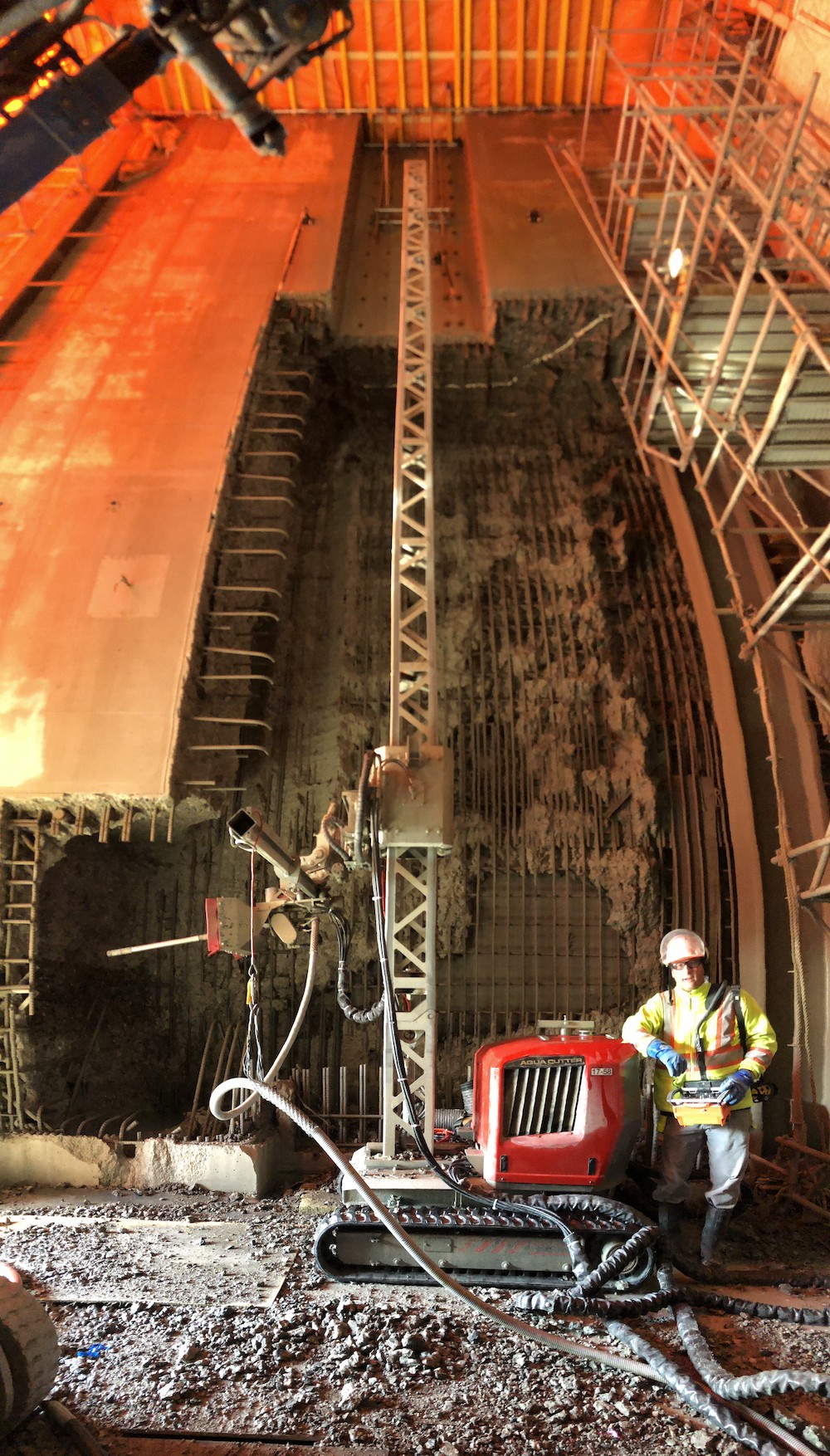
Advantages of robotic options for hydrodemolition
Water Blasting & Vacuum Services began operations more than three decades ago providing household cleaning products, but quickly branched out to include high-pressure cleaning services for industrial, municipal and commercial entities when it recognised a need for innovative, customer-focused solutions in these applications.
As industrial cleaning services grew to become a core market for the company, ensuring employee safety in increasingly hazardous environments encouraged management to explore robotic options.
“The safety of our team members has always been paramount,” said Luc Laforge, president and owner of Water Blasting & Vacuum Services. “Many industrial cleaning applications require long hours in confined spaces and specialized PPE, like forced air systems and chemical protective suits. We wanted to take advantage of any opportunity where we could send in a machine instead of a person.”
While its first hydrodemolition machines were bought used and converted in-house to meet the cleaning challenges of mills and other industrial facilities, the company quickly realized the benefits of working with an original equipment manufacturer to increase precision, safety and efficiency.
“Our old equipment kept the team safe and got the job done, but with most plants slowing down for routine maintenance during the same few months, we needed to find a way to maximise efficiency,” Laforge said.
With one of its pieces of Aquajet equipment – an Aqua Cutter 410A – Laforge saw an 80% increase in efficiency, taking a routine scrubber cleaning application from a 30-hour process to just five.
The power and efficiency of the 410A and additional Aquajet equipment, including a 710V, allowed Water Blasting & Vacuum Services to branch out into Hydrodemolition, hydromilling and other applications, greatly increasing the company’s service offerings.
Over time, a reputation for delivering creative solutions and timely, high-quality results with minimal environmental impact opened the door for even more challenging projects.
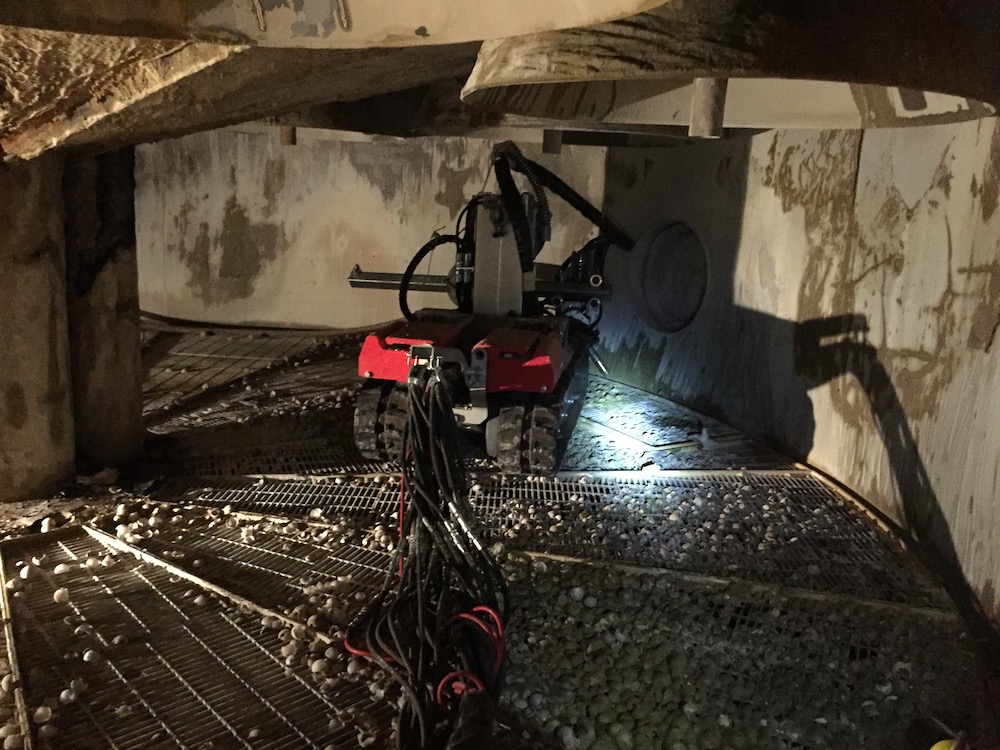
Specialised solution for concrete removal
That reputation put Water Blasting & Vacuum Services on the shortlist for a local hydroelectric company in need of a specialised solution for an unexpected concrete removal job that threatened to delay the project.
“This was a very intriguing project – the first of its kind,” said Maurice Lavoie, general manager at Water Blasting and Vacuum Services and site manager for the project. “The pier was solid concrete, 8ft (2.4m) thick, 40ft (12.2m) wide and 30ft (9m) tall at the highest point.
“A portion of the structure needed to be removed and re-poured. No one in Canada – very few in the world – had used hydrodemolition to vertically remove 8ft-thick concrete. But that was just the start when it came to the complexities and challenges of this job.”
Location was another key challenge. The construction site was approximately 4000km from the contractor’s headquarters in Edmundston, New Brunswick, and 725km north of Winnipeg, Manitoba.
Limited access needed to be carefully factored into any proposed solution. While project managers could provide access to water, power or other general construction supplies, getting speciality equipment or replacement parts presented a time-consuming challenge. Contractors needed dependable equipment and a fully stocked toolbox to limit any unnecessary downtime.
Overcoming challenges
“The project had a lot of challenges to overcome,” Lavoie said. “The remote location left us with no access to technicians or spare parts if something were to go wrong. On top of that, we would be dealing with sub-zero temperatures that could easily get down to 40 below. You had to have a lot of confidence in your team and your equipment to even submit a bid.”
Strict environmental controls also limited contractors’ application choices. The project partners, known as the Keeyask Hydropower Limited Partnership – which includes four Manitoba First Nations and Manitoba Hydro – had made environmental protection a cornerstone of the overall project.
While the original brief specified Hydrodemolition as an acceptable process, the contractors would need to ensure all wastewater was properly collected and treated.
“Whatever technique we used, we had to ensure there would be no negative impact on the surrounding environment,” Lavoie said. “Limiting environmental impact is always an important part of any project for our company, but, when combined with this project’s remote location, we knew there would be additional challenges.
“From previous experience on a jobsite at the Muskrat Falls Generating Project in Labrador, we knew hauling water in and out was an option, but it was costly and inefficient. Treating the water onsite and reusing was the most economical and environmentally friendly solution. And with the Aquajet EcoClear we already had the right machine to make it work.”
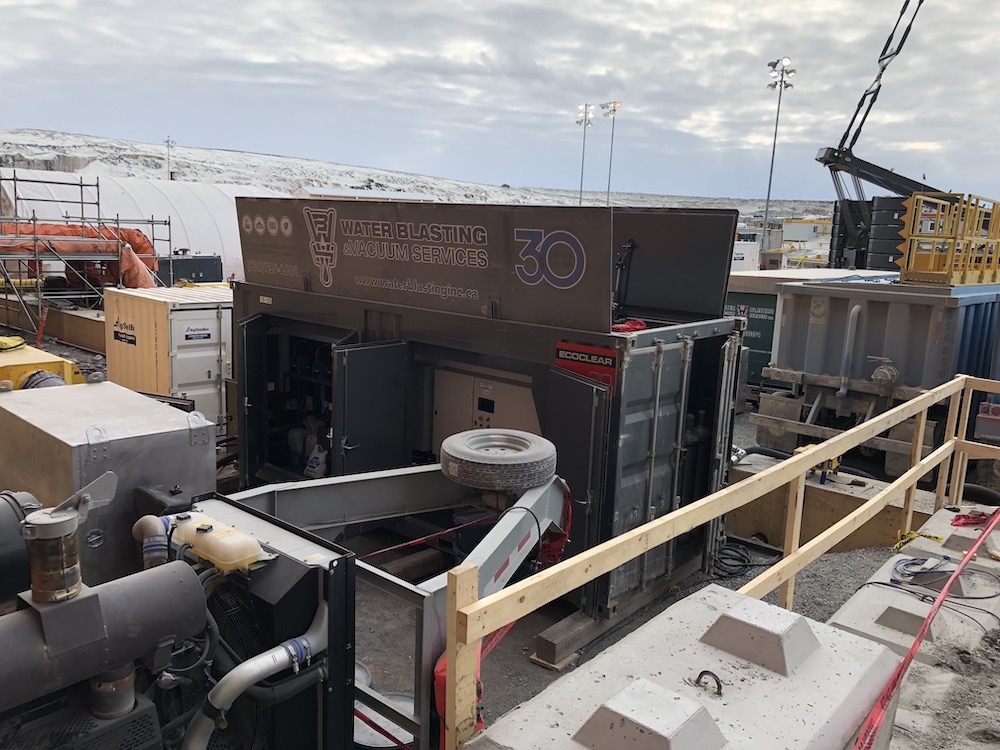
EcoClear water filtration system
The EcoClear water filtration system, in combination with Water Blasting & Vacuum Services’ extensive experience and expert logistics, allowed the contractor to present a revolutionary solution to project managers — one that promised maximum productivity while minimizing resource consumption and protecting the environment.
Water Blasting & Vacuum Services purchased the EcoClear system in 2017 as a more efficient and cost-effective alternative to hauling wastewater with vacuum trucks for off-site treatment. The system neutralizes water pH and reduces turbidity to allow safe release back into the environment. It has the capacity to move up to 88gpm, or about 5,238 gallons (20m3) per hour.
However, for the hydroelectric power project, rather than treating and releasing the water, Water Blasting & Vacuum Services proposed using the EcoClear as part of a closed-loop system that would recycle the water back to its Aqua Cutter 710V.
It would be the company’s first time using the EcoClear to recycle water on such a large scale, but Lavoie and his team were confident the EcoClear and 710V would make the perfect pair to tackle the challenging application.
“This project put our people and equipment to the test,” Lavoie said. “There were a lot of firsts, but we knew we had the experience and the support of the Aquajet team to take our plan from theory to reality.”
Making enhancements to the system
Water Blasting & Vacuum Services arrived at the jobsite in March 2018. With temperatures averaging -20.0 degrees Fahrenheit (-29 degrees Celsius) and dipping as low as -40 degrees Fahrenheit (-40 degrees Celsius) at times, a hoarding system and heaters had to be set up around the demolition site to provide shelter and keep the pumps operating.
In addition to the EcoClear system and 710V, the contractor used a spreader bar and additional tower sections to maximise the Hydrodemolition robot’s reach from the standard 23ft (7m) to 40ft (12.2m). An extension kit allowed the contractor to make a 12-ft (3.7m) wide cut, as well.
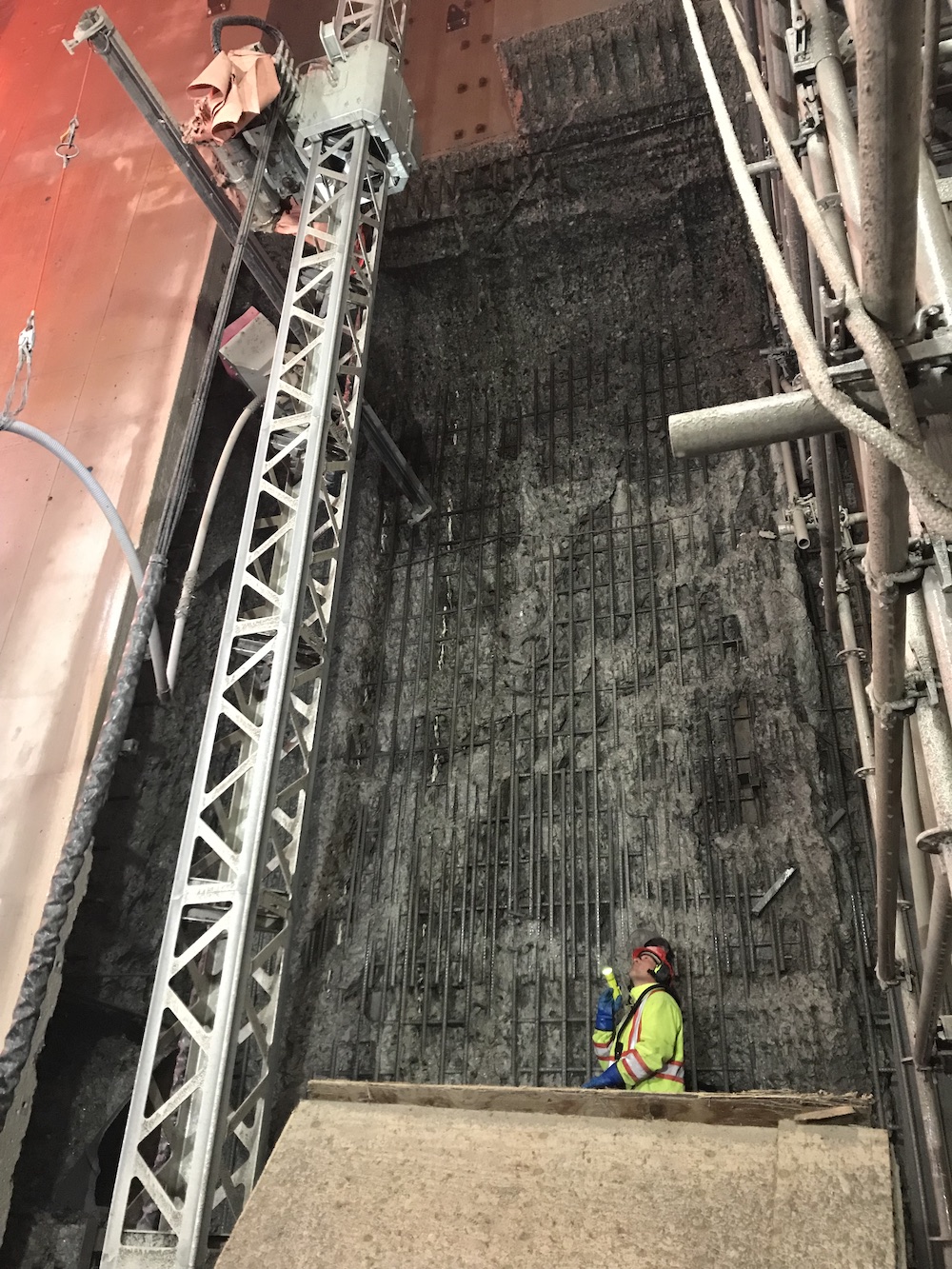
Reducing downtime
These enhancements greatly reduced the downtime frequent repositioning would have required. Additionally, Water Blasting & Vacuum Services employed additional lance sections to increase efficiency and allow the depth the project required.
Steve Ouellette, lead supervisor at Water Blasting & Vacuum Services, was put in charge of the closed-loop system with two 21,000-gallon tanks providing water to the Aqua Cutter 710V. Wastewater was directed to a low point then pumped to the EcoClear.
Once the water was treated, it was pumped back to the holding tanks for reuse. In a 12-hour shift, Water Blasting & Vacuum Services removed an average of 141ft3 (4m3) of concrete and used an estimated 40,000 gallons of water.
Of this, roughly 20% of the water was lost during the hydrodemolition process due to evaporation and absorption into the concrete. However, Water Blasting & Vacuum Services was able to collect and recycle the remaining 80% – 32,000 gallons – with the EcoClear system. Over the course of the project, the EcoClear processed more than 1.3 million gallons of water.
Water Blasting & Vacuum Services worked with project managers to integrate demolition into the complex timeline of the overall project, completing the work in two multi-week phases.
Lavoie and his team operated the Aqua Cutter daily for almost an entire 12-hour shift, working in 12ft (3.7m) wide sections to completely demolish the wall. A separate crew would come on at night to remove rebar and debris.
The process repeated for approximately 41 days of blasting and a total of 53 days onsite.
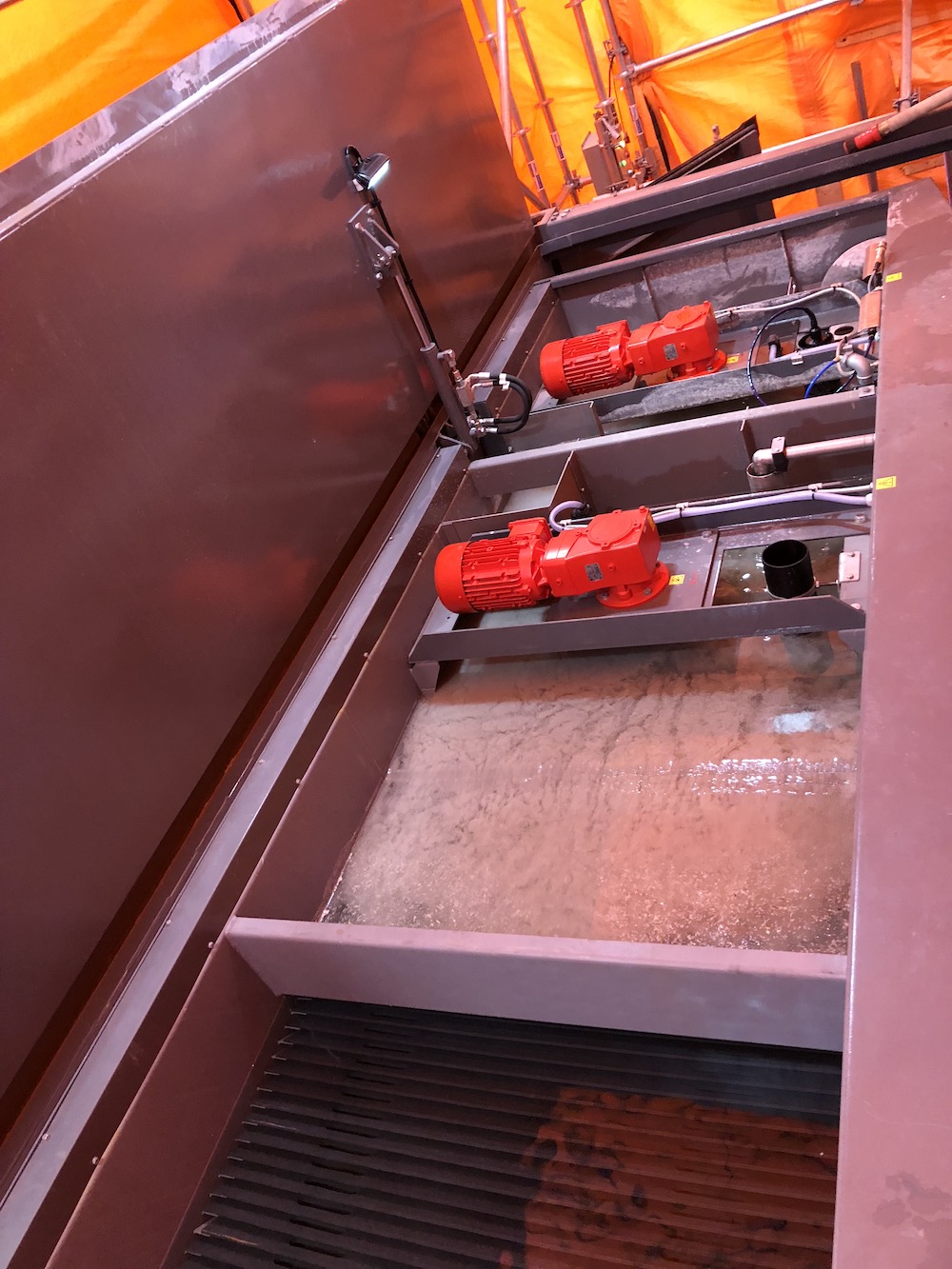
Powering through to new opportunities
Water Blasting & Vacuum Services completed demolition in May 2018. Thanks to a revolutionary and expertly executed plan, as well as innovative equipment, the removal did not disrupt the timeline of the overall project.
“Projects like that are once in a lifetime,” Laforge said. “Thanks to a dedicated team with the experience and daring to take on the impossible and innovative equipment, we were able to find a unique solution that allowed us to push the boundaries of Hydrodemolition and be part of such an important construction.”






